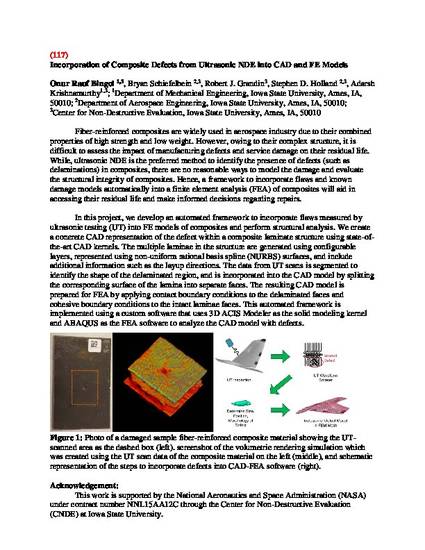
Article
Incorporation of Composite Defects from Ultrasonic NDE into CAD and FE Models
Review of Progress in Quantitative Nondestructive Evaluation
Start Date
2016 12:00 AM
Disciplines
Description
Fiber-reinforced composites are widely used in aerospace industry due to their combined properties of high strength and low weight. However, owing to their complex structure, it is difficult to assess the impact of manufacturing defects and service damage on their residual life. While, ultrasonic NDE is the preferred method to identify the presence of defects (such as delaminations) in composites, there are no reasonable ways to model the damage and evaluate the structural integrity of composites. Hence, a framework to incorporate flaws and known damage models automatically into a finite element analysis (FEA) of composites will aid in accessing their residual life and make informed decisions regarding repairs.
In this project, we develop an automated framework to incorporate flaws measured by ultrasonic testing (UT) into FE models of composites and perform structural analysis. We create a concrete CAD representation of the defect within a composite laminate structure using state-of-the-art CAD kernels. The multiple laminae in the structure are generated using configurable layers, represented using non-uniform rational basis spline (NURBS) surfaces, and include additional information such as the layup directions. The data from UT scans is segmented to identify the shape of the delaminated region, and is incorporated into the CAD model by splitting the corresponding surface of the lamina into separate faces. The resulting CAD model is prepared for FEA by applying contact boundary conditions to the delaminated faces and cohesive boundary conditions to the intact laminae faces. This automated framework is implemented using a custom software that uses 3D ACIS Modeler as the solid modeling kernel and ABAQUS as the FEA software to analyze the CAD model with defects
Language
en
File Format
application/pdf
Citation Information
Onur Rauf Bingol, Bryan Schiefelbein, Robert J. Grandin, Stephen D. Holland, et al.. "Incorporation of Composite Defects from Ultrasonic NDE into CAD and FE Models" (2016) Available at: http://works.bepress.com/stephen_holland/52/
